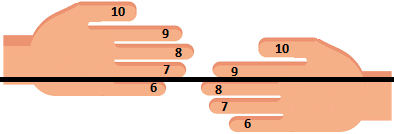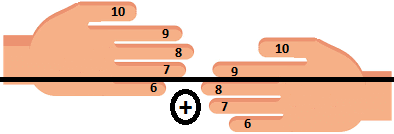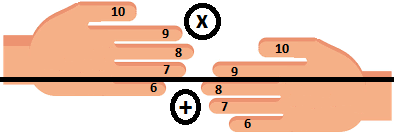5. 2nd multiplication method
The 2nd method of multiplication is based on the following equality:
a x b = (a + b – r) x r + (a – r) x (b – r)
or
a x b = (a + b – r) x r + (r – a) x (r – b)
This method makes the multiplication calculation easy, especially when the two values to be multiplied are close to each other.
1st example
For example: 18 x 13
I have chosen the value 10 for the reference which I have represented by "r". Notice how easy the calculation of this multiplication is!
| I add up | 18+13=31 | |
| I subtract 10 | 31-10=21 | |
| I multiply by 10 | 21x10=210 | I memorise 210 |
| I multiply the differences from 10 | 8x3=24 | I add 24 and 210, I get the result 234 |
You can check that 18 x 13 = 234.
NB. I subtracted the reference 10 in the second step. But, in this case, you may well start by subtracting reference 10 from one of the two values and then adding the rest to the other value. For example, 18-10=8, then add 8+13=21. This makes the calculation a little easier. However, in the following example where both values are less than the reference, you should first add the two values and then subtract the reference from the result.
2nd example
For example: 8 x 6
That's 48; it must be memorised. But let's apply the method described above, always using the reference 10.
This is useful for understanding the method and also a help if you have not learned all the multiplication tables well.
| I add up | 8+6=14 | |
| I subtract 10 | 14-10=4 | |
| I multiply by 10 | 4x10=40 | I memorise 40 |
| I multiply the differences from 10 | 2x4=8 | I add 8 to 40, I get the result 48 |
Let us now open a parenthesis. People use their fingers to find the products of numbers between 6 and 9. This way of counting with the fingers can be explained by the method we are studying in this section.
I describe this way of using fingers by taking the same example: 6x8 :
1st rule: the fingers of both hands are numbered from the little finger to the thumb with the values 6 to 10.

2nd rule: to calculate 6x8, I have to put finger number 6 (which is the little finger) of the left hand opposite finger number 8 (which is the middle finger) of the right hand. And I imagine a line drawn just above these two fingers

3rd rule: I count the fingers at the bottom of this line and this is the tens number. In our case it is 1+3=4.
NB. Note that this is equivalent to 6-5+8-5 which is equal to 6+8-10. So we find the formula shown above.

4th rule: I count the fingers at the top of the line for each hand and multiply them to find the number of units. In our case it is 4x2=8.
NB. Note that this is equivalent to (10-6)x(10-8). So we still find the formula used for our method.

3rd example
For example: 16 x 7
Here again we will use the reference 10. But notice that one value is greater than 10 while the other is less than 10. When this is the case, the product of the differences from reference 10 should be subtracted, not added.
| I add up | 16+7=23 | |
| I subtract 10 | 23-10=13 | |
| I multiply by 10 | 13x10=130 | I memorise 130 |
| I multiply the differences from 10 | 6x3=18 | I subtract 18 from 130, I get the result 112 |
Example with 100 as reference
For example: 94 x 109
Both values of the operation are close to 100; let's use 100 as reference:
| I add up |
94+109 |
|
| I subtract 100 | 203-100 =103 |
|
| I multiply by 100 |
103x100 |
I memorise 10300 |
| I multiply the differences from 100 | 6x9=54 | I subtract 54 from 10300, I get the result 10246 |
Example with 20 as reference
For example: 23 x 29
Let's use 20 as a reference:
| I add up | 23+29=52 | |
| I subtract 20 | 52-20=32 | |
| I multiply by 20 | 32x20 =32x2x10 =640 |
I memorise 640 |
| I multiply the differences from 20 | 3x9=27 | I add 27 to 640, I get the result 667 |
Another example : 31 x 56
1st solution
Let's use 40 as reference:
| I add up | 31+56=87 | |
| I subtract 40 | 87-40=47 | |
| I multiply by 40 |
47x40 |
I memorise 1880 |
| I multiply the differences from 40 |
9x16 |
I subtract 144 from 1880, I get the result 1736 |
2nd solution
31 x 56 = 31 x 28 x 2
We can facilitate this by first calculating 31 x 28 and then multiplying the result by 2.
To calculate 31 x 28, let's use 30 as reference:
| I add up | 31+28=59 | |
| I subtract 30 | 59-30=29 | |
| I multiply by 30 | 29x30 =(30x30)-30 =900-30 =870 |
I memorise 870 |
| I multiply the differences from 30 | 1x2=2 | I subtract 2 from 870, I get the result 868 |
I then multiply 868 by 2, and get the result:
31 x 56 = 1736
Example with double use of the method
For example: 144 x 123
Let's use 100 as a reference:
| I add up | 144+123=267 | |
| I subtract 100 | 267-100=167 | |
| I multiply by 100 | 167x100 =16700 |
I memorise 16700 |
| I multiply the differences from 100 | 44x23 =22x23x2 |
??? |
I will reapply the method using reference 20 to calculate 22 x 23. I then multiply the result by 2.
| I add up | 22+23=45 | |
| I subtract 20 | 45-20=25 | |
| I multiply by 20 |
25x20 |
I memorise 500 |
| I multiply the differences from 20 | 2x3=6 | I add 6 to 500, I get the result 506 |
44 x 23 = 22 x 23 x 2 = 506 x 2 = 1012
An aside: the calculation of 44 x 23 can be done in another way if I notice that 44=11x4 :
23 x 44 = 23 x 11 x 2 x 2 = 253 x 2 x 2 = 506 x 2 = 1012
Let's go back to our main problem. I have stored 16700, I need to add 1012 to it. The result is :
144 x 123 = 17712
Particular cases
Product of 2 values with the same number of tens and whose unit digits complement each other to 10
To calculate the product of 2 values with the same number of tens and whose unit digits complement each other to 10 :
- Multiply the tens digit by the next digit and put the result in hundreds
- Calculate the product of the units and add it to the previous result
Example 67 x 63 :
- Calculate 6 x 7 = 42, I memorise 4 200
- Calculate 7 x 3 = 21. I add 21 to 4200. The result is 4 221
NB. This is a special case of using the method studied in this section.
Square of a number whose unit digit is 5
To calculate the square of a number whose units digit is 5 :
- Multiply the tens digit by the next digit and put the result in hundreds
- Add 25 to the previous result
Example : 352
- Calculate 3 x 4 = 12,
- The result is 1225.
When the two values are not close to each other
It is possible to use the method when the two values to be multiplied are not close to each other, but using two references:
If one reference is a multiple of the other, use the formula :
a x b = (k x a + b - k x r) x r + (a – r) x (b – k x r)
If both references are multiples of the same value, use the formula :
a x b = (l x a + b x k – k x l x r) x r + (a – k x r) * (b – l x r)
Example : 43 x 18
I use 40 and 20 as references. 40 is a multiple of 20. I therefore use the 1st formula with k=2 (because 40=20x2)
| I add 43 and 18x2 (*) |
43+(18x2) |
|
| I subtract 40 (**) | 79-40=39 | |
| I multiply by 20 (***) | 39x20 =(40x20)-20 = 800-20 =780 |
I memorise 780 |
| I multiply the differences from the references | 3x2=6 | I subtract 6 from 780, I get the result 774 (****) |
(*) I multiplied the small value with the factor k
(**) I have subtracted the upper reference
(***) I multiplied by the lower reference
(****) I have subtracted because 43 is higher than its reference 40 and 18 is lower than its reference 20.
Example : 52 x 34
I use 50 and 30 as references. 50 and 30 are multiples of 10 with k=5 and l=3 as factors
| I add 52x3 and 34x5 (*) | (52x3)+(34x5) =156+170 = 326 |
|
| I subtract 10x3x5 (**) | 326-150=176 | |
| I multiply by 10 (***) | 176x10=1760 | I memorise 1760 |
| I multiply the differences from the references | 2x4=8 | I add 8 to 1760, I get the result 1768 |
(*) I have multiplied the values with the factors in a crosswise manner
(**) I have subtracted the common divisor of the two references multiplied by the two factors
(***) I have multiplied by 10 which is the common divisor of the two references.